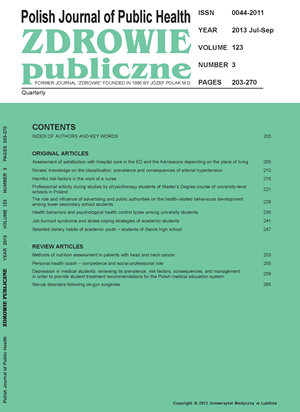Health behaviors and psychological health control types among university students
DOI:
https://doi.org/10.12923/j.0044-2011/123-3/a.06Keywords:
health locus of control types, health behavior, health promotion, health education, studentsAbstract
Introduction. The factors that influence gaining good results of prophylactic programs are human attitudes to health. These attitudes manifest themselves as individual beliefs and health-oriented behaviors.
Aim. The aim of the research was to investigate relations between the health control types and health behaviors performed by the university students.
Material and methods. The research was conducted in the group of 532 Polish university students in 2009. The average age in the researched group was M=20.74 (SD=1.542). Two questionnaires were used in the survey: the Multidimensional Health Locus of Control Scale (MHLC) worked out by Wallston, Wallston & R. DeVellis and the Inventory of Health Behaviors (IHB) by Juczynski. The MHLC scale allows for evaluating three dimensions of the health locus of control, namely: Internal Health Locus of Control (IHLC), Powerful Others Health Locus of Control (PHLC) and Chance Health Locus of Control (CHLC). The Inventory of Health Behaviors (IHB) allows for estimating various kinds of health behaviors categorized into four groups: diet habits, preventive behaviors, positive psychical attitude and health practices.
Results. The health behaviors correlate most strongly with the PHLC dimension. The higher result in the PHLC dimension was obtained, the higher were the results in the following three dimensions: preventive behaviors, positive psychical attitudes and health practices.
Conclusions. Students manifest the belief that internal control (IHLC) prevail over external sources of health control (PHLC, CHLC). In the studied group, the women have exhibited significantly greater intensification of good diet habits and preventive behaviors. The main factor modifying preventive behaviors performed by researched students is the belief in the influence of other people on the students’ health status
References
1. Rotter JB. Generalized expectancies for internal versus external control of reinforcement. Psychol Monogr. 1966;80(1).
2. Wallston KA, Wallston BS, DeVellis RF. Development of the Multidimensional Health LOC (MHLC) Scales. Health Educ Monogr. 1978;6:160-70. Review match
3. Wallston KA. Multidimensional Health Locus of Control (MHLC). Scales; 1978. [http://www.vanderbilt.edu/nursing/kwallston/mhlcscales.htm]
4. Luszczynska A, Schwarzer, R. Multidimensional Health Locus of Control: Comments on the Construct and its Measurement. J Health Psych. 2005;10(5):633-42. Review match
5. Masters KS, Wallston KA. Canonical correlation reveals important relations between health locus of control, coping, affect and values. J Health Psych. 2005;10:719-31. Review match
6. Acharya S. Professionalization and Its Effect on Health Locus of Control Among Indian Dental Students. J Dent Educ. 2008;72(1):110-5. Review match
7. Acharya S, Sangam DK. Oral health-related quality of life and its relationship with health locus of control among Indian dental university students. Eur J Dent Educ. 2008;12:208-12. Review match
8. Shamsedden W, Mahmoud H, Otrock Z, AfifiSoweid R. Health Locus of control among medical students in a developing country. Int J Health Promot Educ. 2006;44:145-51. [http://findarticles.com/p/articles/mi_6793/is_4_44/ai_n28405795]
9. Trankle SA, Haw J. Predicting Australian health behaviour from health beliefs. Elec J of App Psychol. 2009;5(2):9-17.
10. Steptoe A, Wardle J. Health behaviour, risk awareness and emotional well-being in students from Eastern Europe and Western Europe. Soc Sci Med. 2001;53:1621-30. Review match
11. Steptoe A, Wardle J, Cui W, et al. Trends in Smoking, Diet, Physical Exercise, and Attitudes Toward Health in European University Students from 13 Countries, 1990-2000. Prev Med. 2002;35:97-104. Review match
12. Pasch KE, Perry CL, Stigler MH, Komro KA. Sixth grade students who use alcohol: do we need primary prevention programs for “tweens”? Health Educ Behav. 2009;36(4):673-95. Review match
13. Christiansen M, Vik PW, Jarchow A. College student heavy drinking in social contexts versus alone. Addictive Behav. 2002;27:393-404. Review match
14. Steptoe A, Wardle J. Locus of control and health behavior revisited: A multivariate analysis of young adults from 18 countries. Br J Psychol. 2001;92:659-72. Review match
15. Juczynski Z. Narzędzia pomiaru w promocji i psychologii zdrowia. Warszawa: Pracownia Testów Psychologicznych Polskiego Towarzystwa Psychologicznego; 2001.
16. Baş M, Altan T, Dinçer D, et al. Determination of dietary habits as a risk factor of cardiovascular heart disease in Turkish adolescents. Eur J Nutr. 2005;44(3):174-82. Review match
17. Wallston KA. Overview of the Special Issue on Research with the Multidimensional Health Locus of Control (MHLC) Scales. J Health Psychol. 2005;10(5):619-21. Review match
18. Rock, DL, Meyerowitz BE, Maisto SA, Wallston KA. The derivation and validation of six multidimensional health locus of control scale clusters. Res Nurs Health. 1987;10(3):185-95. Review match
19. Wiegmann SM, Bergen NL. Health Locus-of-Control Beliefs and Improvement in Physical Functioning in a Work-Hardening, Return-to-Work Program. Rehabil Psychol.1998;43(2):83-100. Review match.


